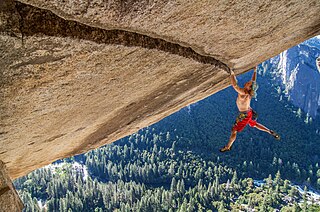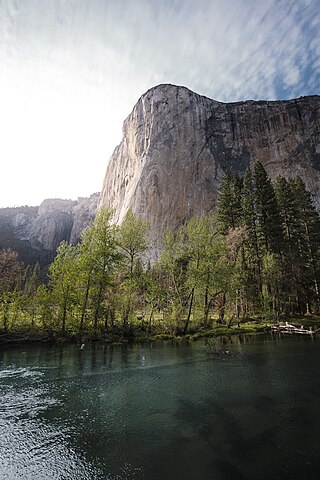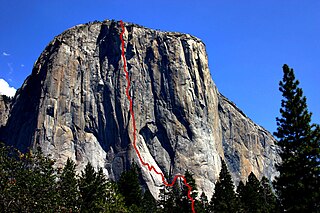
Climbing is the activity of using one's hands, feet, or other parts of the body to ascend a steep topographical object that can range from the world's tallest mountains to small boulders. Climbing is done for locomotion, sporting recreation, for competition, and is also done in trades that rely on ascension, such as rescue and military operations. Climbing is done indoors and outdoors, on natural surfaces, and on artificial surfaces

A climbing route is a path by which a climber reaches the top of a mountain, or rock/ice-covered obstacle. The details of a climbing route are recorded in a climbing guidebook and/or in an online climbing route database, and will include elements such as the type of climbing route, the difficulty grade of the route–and beta on its crux(es)–and any risk or commitment grade, the length and number of pitches of the route, and the climbing equipment needed to complete the route.

El Capitan is a vertical rock formation in Yosemite National Park, on the north side of Yosemite Valley, near its western end. The granite monolith is about 3,000 feet (914 m) from base to summit along its tallest face and is a world-famous location for big wall climbing, including the disciplines of aid climbing, free climbing, and more recently for free solo climbing.

Alexander Huber is a German rock climber who is considered one of the greatest and most influential climbers in the history of rock climbing. Huber came to prominence in the early 1990s as the world's strongest sport climber after the passing of Wolfgang Güllich. He is the second-ever person to redpoint a 9a (5.14d) graded route by ascending Om in 1992, and has latterly come to be known as the first-ever person to redpoint a 9a+ (5.15a) graded route from his 1996 ascent of Open Air.

Solo climbing, or soloing, is a style of climbing in which the climber climbs a route alone, without the assistance of a belayer. By its very nature, it presents a higher degree of risk to the climber, and in some cases, is considered extremely high risk. Note that the use of the term "solo climbing" is generally separate from the action of bouldering, which is itself a form of solo climbing, but with less serious consequences in the case of a fall. The most dangerous form of solo climbing is free solo climbing, which means both climbing alone and without any form of climbing protection.

Multi-pitch climbing is a type of climbing that typically takes place on routes that are more than a single rope length in height, and thus where the lead climber cannot complete the climb as a single pitch. Where the number of pitches exceeds 6–10, it can become big wall climbing, or where the pitches are in a mixed rock and ice mountain environment, it can become alpine climbing. Multi-pitch rock climbs can come in traditional, sport, and aid formats. Some have free soloed multi-pitch routes.

Tommy Caldwell is an American rock climber who has set records in sport climbing, traditional climbing, and in big-wall climbing. Caldwell made the first free ascents of several major routes on El Capitan in Yosemite National Park.

The Regular Northwest Face of Half Dome was the first Grade VI big wall climbing route in the United States. It was first climbed in 1957 by a team consisting of Royal Robbins, Mike Sherrick, and Jerry Gallwas. Its current aid climbing rating is VI 5.9 A1 or 5.12 for the free climbing variation. It is recognized in the historic climbing text Fifty Classic Climbs of North America and considered a classic around the world.

Rope-solo climbing or rope-soloing is a form of solo climbing, but unlike with free solo climbing, which is also performed alone and with no climbing protection whatsoever, the rope-solo climber uses a mechanical self-belay device and rope system, which enables them to use the standard climbing protection to protect themselves in the event of a fall.

In the history of rock climbing, the three main sub-disciplines—bouldering, single-pitch climbing, and big wall climbing—can trace their origins to late 19th-century Europe. Bouldering started in Fontainebleau, and was advanced by Pierre Allain in the 1930s, and John Gill in the 1950s. Big wall climbing started in the Dolomites, and was spread across the Alps in the 1930s by climbers such as Emilio Comici and Riccardo Cassin, and in the 1950s by Walter Bonatti, before reaching Yosemite where it was led in the 1950s to 1970s by climbers such as Royal Robbins. Single-pitch climbing started pre-1900 in both the Lake District and in Saxony, and by the late-1970s had spread widely with climbers such as Ron Fawcett (Britain), Bernd Arnold (Germany), Patrick Berhault (France), Ron Kauk and John Bachar (USA).

Big wall climbing is a form of rock climbing that takes place on long multi-pitch routes that normally require a full day, if not several days, to ascend. In addition, big wall routes are typically sustained and exposed, where the climbers remain suspended from the rock face, even sleeping hanging from the face, with limited options to sit down or escape unless they abseil back down the whole route. It is therefore a physically and mentally demanding form of climbing.

The Nose is a big wall climbing route up El Capitan. Once considered impossible to climb, El Capitan is now the standard for big wall climbing. It is recognized in the historic climbing text Fifty Classic Climbs of North America and considered a classic around the world.

The Salathé Wall is one of the original big wall climbing routes up El Capitan, a 3,000-foot (900 m) high granite monolith in Yosemite National Park. The Salathé Wall was named by Yvon Chouinard in honor of John Salathé, a pioneer of rock climbing in Yosemite. The route is recognized in the historic climbing text Fifty Classic Climbs of North America and is considered a classic around the world.

Alex Honnold is an American rock climber best known for his free solo ascents of big walls. Honnold rose to worldwide fame in June 2017 when he became the first person to free solo a route on El Capitan in Yosemite National Park, a climb described in The New York Times as "one of the great athletic feats of any kind, ever." Honnold also holds the record for the fastest ascent of the "Yosemite Triple Crown", an 18-hour, 50-minute link-up of Mount Watkins, The Nose, and the Regular Northwest Face of Half Dome. In 2015, he won a Piolet d'Or in alpine climbing with Tommy Caldwell for their completion of the enchainment of the Cerro Chaltén Group in Patagonia over 5 days.

Alpine climbing is a type of mountaineering that involves using any of a broad range of advanced climbing skills, including rock climbing, ice climbing, and/or mixed climbing, to summit typically large routes in an alpine environment. While alpine climbing began in the European Alps, it is used to refer to climbing in any remote mountainous area, including in the Himalayas and in Patagonia. The derived term alpine style refers to the fashion of alpine climbing to be in small lightly-equipped teams who carry all of their own equipment, and do all of the climbing.

Free Solo is a 2018 American documentary film directed by Elizabeth Chai Vasarhelyi and Jimmy Chin that profiles rock climber Alex Honnold on his quest to perform the first-ever free solo climb of a route on El Capitan, in Yosemite National Park, in June 2017.
Marc-André Leclerc was a Canadian rock climber, ice and mixed climber, and alpinist. He is known for his solo ascents–often in winter–of major ice and alpine climbing routes. In 2016, he completed the first winter solo ascents of both Torre Egger in Patagonia and of the Emperor Face of Mount Robson in Canada. In 2018, he was killed in an avalanche on the Mendenhall Towers in Alaska.

The Alpinist is a 2021 American documentary film directed by Peter Mortimer and Nick Rosen about Marc-André Leclerc, a free-spirited and little-known 23-year-old Canadian rock climber, ice climber, and alpinist. From 2015 to 2016, a film crew followed Leclerc as he solo climbed some of the most difficult and dangerous alpine climbing routes in the world.



![Heinz Zak [de] free soloing Separate Reality in 2005; Zak had taken the iconic photograph of Wolfgang Gullich making the first free solo of Separate Reality in 1986 Heinz Zak, Separate Reality 5,11d, Free Solo, Yosemite-Nationalpark, Kalifornien, USA.jpg](http://upload.wikimedia.org/wikipedia/commons/thumb/2/26/Heinz_Zak%2C_Separate_Reality_5%2C11d%2C_Free_Solo%2C_Yosemite-Nationalpark%2C_Kalifornien%2C_USA.jpg/220px-Heinz_Zak%2C_Separate_Reality_5%2C11d%2C_Free_Solo%2C_Yosemite-Nationalpark%2C_Kalifornien%2C_USA.jpg)





















